Intel Unveils 10th Gen Core Ice Lake-U & Ice Lake-Y Mobile CPUs: 10nm Sunny Cove Later This Year
by Ian Cutress on May 29, 2019 8:00 AM EST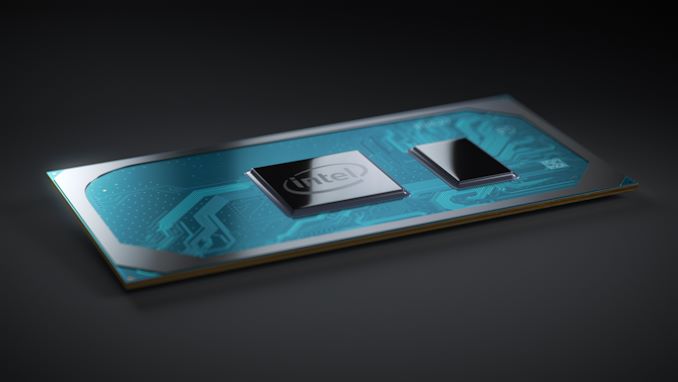
At Intel’s Keynote presentation here at Computex, the company finally lifted the lid on its first widely available new CPU design on its 10nm process, called Ice Lake. The official marketing name for these processors will be ‘Intel 10th Generation Core’, and will feature up to four CPU cores with Intel's new Sunny Cove architecture, new Gen11 graphics supplying up to 1TF of graphics/compute performance, and built in support for Wi-Fi 6 and Thunderbolt 3.
The story of Intel’s 10nm is a long and drawn out one, which we covered when we reviewed the first 10nm CPU, Cannon Lake, which only ended up in some limited Chinese system launch. Fast forward almost 2.5 years from when Intel officially announced it was shipping those 10nm CPUs and we have a full launch of Ice Lake, built on the company's greatly refined second-generation 10+ process. Intel spent a lot of its keynote presentation going through how it has driven the ecosystem and its ecosystem partners around developing systems with the new CPU in mind.
Intel is officially launching 11 different CPUs in the 10th Gen Core lineup, ranging from Core i3 to Core i7. Details on the specifications of those CPUs has not actually been released, which raises a number of questions of how much of a launch this actually is, however we do know that the best CPUs will have a turbo frequency up to 4.1 GHz and a top GPU frequency of 1.1 GHz. Users might consider this lower than 9th Gen mobile parts, which again raises questions. CPUs will be coming to market with 9W, 15W, and 28W variants.
Intel’s partners however have given us some specifications, and it shows in interesting adjustment in the naming scheme.
| OEM-Listed Intel Ice Lake 10nm CPUs | ||||||
| AnandTech | Core Threads |
Base Freq |
Turbo Freq |
IGP | TDP | Price (1ku) |
| i7-1065 G7 | 4C/8T | 1.3 GHz | 3.9 GHz | Yes | ? | ? |
| i5-1035 G1 | 4C/8T | ? | 3.7 GHz | Yes | ? | ? |
| i3-1005 G1 | 2C/4T | ? | 3.4 GHz | Yes | ? | ? |
At this point in time we’re not sure exactly what the ‘G7’ or ‘G1’ means in the name. It could be related to graphics, given that Intel will launch CPUs with 32 EUs, 48 EUs, or 64 EUs.
In accordance with their trio of TDPs, Intel has confirmed that there will be both Y-series and U-series Ice Lake parts. As a refresher, Intel's Y-series parts are their most compact, lowest-power chips, designed for passively cooled devices and other devices with limited cooling options, like 2-in-1s. Y-series chips have a nominal TDP of 9W – notably higher than the 5W TDPs for the current-generation Amber Lake-Y parts – and will be able to cTDP Up to 12W. Meanwhile Intel's U-series will, it appears, be the flag bearer for Ice Lake. These parts will have a nominal TDP of 15W, and can cTDP Up to 25W.
According to Intel's official product brief, both the U-series and Y-series parts will come with integrated GPUs with up to 64 EUs – this being particularly notable since the Y-series parts are going to be so low power. However it looks like Intel is going to split up the U-series a bit; 32 EU parts are listed as "Ice Lake U UHD", while 48 and 64 EU parts are "Ice Lake U Iris Plus". So Intel's Iris Plus branding will remain; and hopefully Iris Plus Ice Lake SKUs will be more common than today's Iris Plus parts.
Intel has discussed Ice Lake to a certain degree back in December and more recently at a private event, which we will be publishing after Computex to give it the attention it deserves. But the new core is designed to have more execution units, wider out-of-order windows, better load/store functionality, a bigger cache arrangement, and Intel states that this is good for an average 18% raw clock-for-clock performance uplift compared to the original Skylake core released in 2016.
Users might be surprised about this 18% number, given that Intel has historically only provided low single digit boosts in recent generations. The reason for those single digit boosts comes down mainly to small parts of the core microarchitecture being widened. For Ice Lake, the doubling of the L2 cache, the increase in execution ports, and the dispatch capabilities of the front end of the core all provide big improvements. Intel also states that the pre-fetchers are improved, which also helps with that 18% IPC increase. It will be interesting to get hold of a system and to actually test/compare with Skylake, especially with all the security patches applied.
For graphics, Intel is stating that the best 10th Gen Core designs will be able to compete with what AMD has to offer with its mobile APU platforms. By increasing the number of execution units from 24 EUs to 64 EUs, Intel is promising over a 2x boost in graphics performance, which is facilitated by the better cache design on the CPU. The new graphics architecture, along with aggressive driver updates, should provide Intel better positioning in the thin-and-light gaming market. Benchmarks shown by Intel include many of the popular titles running today at 1920x1080 at either low or medium settings.
Core functionality aside, the new chips are also incorporating some of the latest I/O features. The biggest news here, of course, is integrated Thunderbolt 3 support for the on-chip 300 series mobile chip, finally doing away with the need for a separate PCIe-to-Thunderbolt controller. Not only will this save laptop OEMs space in their design, but as it's now a baseline feature of Intel's mobile chips, Thunderbolt 3 should become nearly ubiquitous across low-power laptops. Which considering that Thunderbolt 3 has been released to the world at large to be used as the basis for USB4, it's clear that Thunderbolt technology is quickly going to become a necessary feature for future laptops.
The other notable change here is support for Wi-Fi 6 (802.11ax), via Intel's increasingly well-established CNVi program. As with Intel's first-generation integrated Wi-Fi 5 functionality, Wi-Fi 6 is integrated in two parts. The Wi-Fi 6 Media Access Controller (MAC) is on Intel's chipset, meanwhile the RF hardware is on a separate companion module. Going this route is optimal for OEMs for regulatory reasons – the RF module can be certified separately – though it does mean they'll need to buy the RF module to make use of the processor's on-chip Wi-Fi capabilities. Interestingly, neither Intel nor the rest of the industry is wasting any time here; even though the Wi-Fi 6 standard hasn't been fully approved yet – it's still draft – it's already being integrated into hardware wide and far, including now mobile PC processors.
Overall, a number of ecosystem partners are at the Computex show with 10th Gen Core designs, including Dell, HP, Lenovo and others. For this new generation, Intel is also pushing its new Athena project, which we're covering in a separate article.
AnandTech's deep dive coverage of Intel 10th Gen Core will continue after Computex, with more details an analysis of the core microarchitecture. We're also working with Intel to get more access to Ice Lake platforms so we can provide a full testing profile of the new CPU family.
| Want to keep up to date with all of our Computex 2019 Coverage? | ||||||
 Laptops |
 Hardware |
 Chips |
||||
| Follow AnandTech's breaking news here! | ||||||


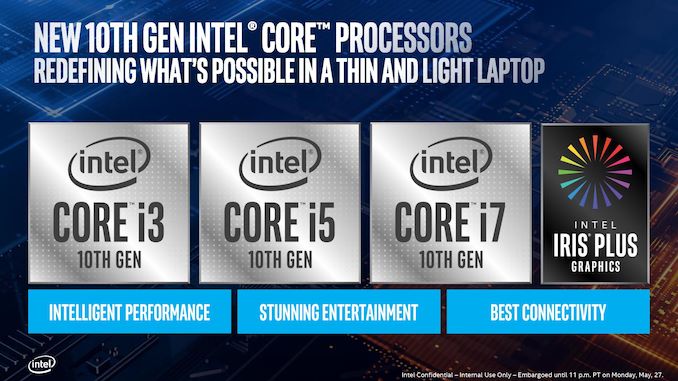
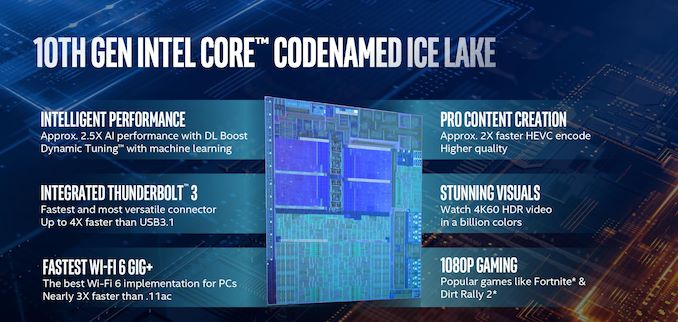
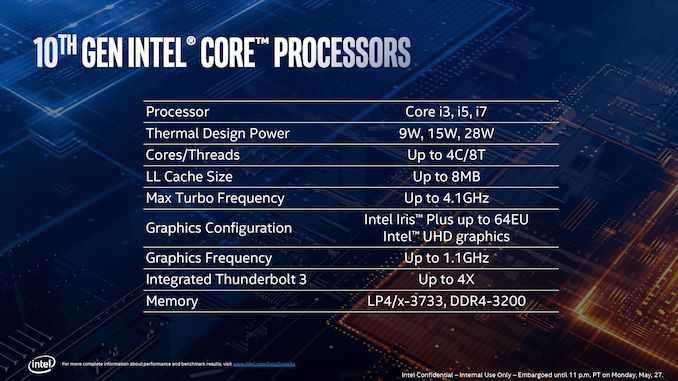
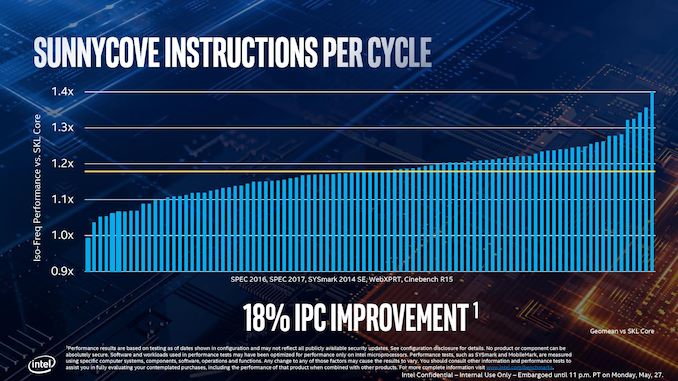
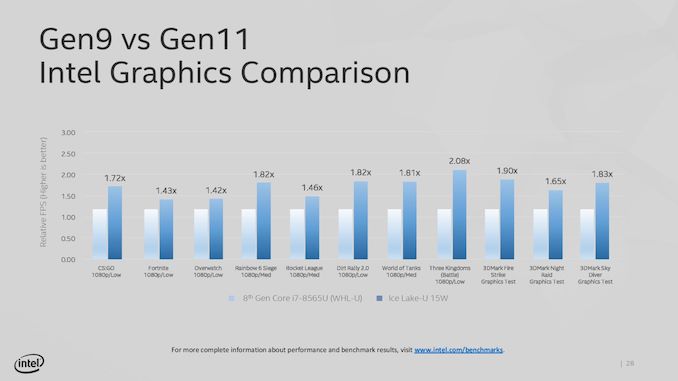
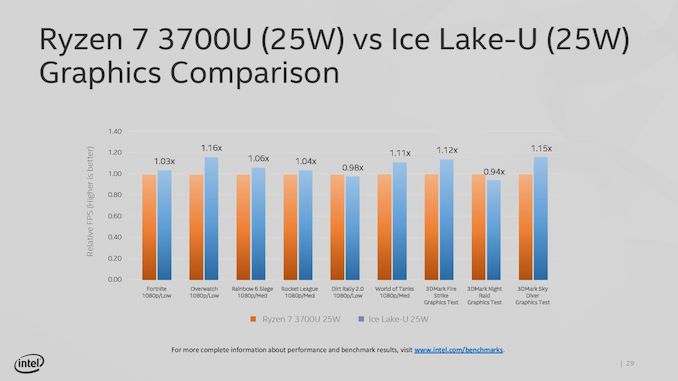
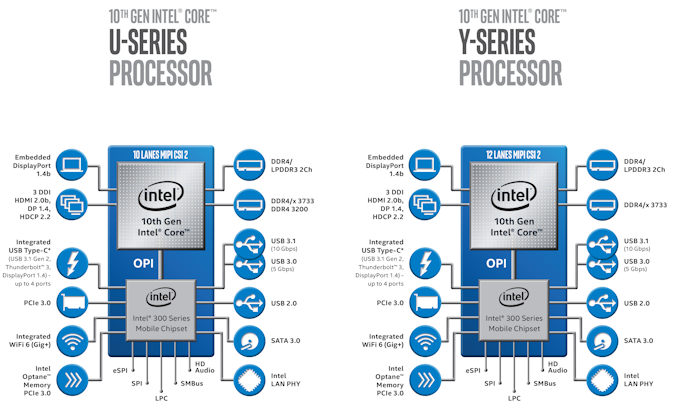








190 Comments
View All Comments
catavalon21 - Wednesday, May 29, 2019 - link
Amused at your response to HStewart for misspelling a word, then you proceed to follow with two misspelled words of your own (or one with another wrong word). Spelled correctly, the second paragraph would start (capitalizing words that are corrected) ...it ISN'T different THAN skylake...Glass houses and all
Korguz - Wednesday, May 29, 2019 - link
catavalon21 the joy of typing on my phone.. vs my keyboard.. but if you look at ALL of HStewarts posts on here.. he ALWAYS spells architeCture wrong... ALWAYS, thats the difference...im sure you have spelled words wrong ( like any one else ) when typing on a phone.. vs keyboard :-)
catavalon21 - Thursday, May 30, 2019 - link
Sure, I also make tons of typing errors on a full sized keyboard. I type poorly and often do a crummy job of proofreading. I also know that for many contributors on AT, English is not their first language, and try to keep that in mind when the tendency to get picky hits me.phoenix_rizzen - Thursday, May 30, 2019 - link
All the Lakes are the same basic architecture with refinements and enhancements and the of new feature. It's pretty much advertised in the name.The *wells were based on the same architecture, which changed going into the *Lakes.
No different than how AMD iterated over the Bulldozer architecture all the way through Excavator/Kaveri, then switched to Zen. Then they iterated over Zen with Zen+. Now they have a new architecture with Zen 2.
Maybe next year Intel will have a new architecture to base their chips on that's as different to Skylake as Skylake was to Broadwell. That's when the Faveros and EMIB stuff should get interesting.
phoenix_rizzen - Thursday, May 30, 2019 - link
If you think back to "the old days", an existing architecture was used across two nodes, then a new architecture was released on the new node (tick-tock setup).Skylake was the new architecture on an existing node. All the Lakes have been iterations over slightly tweaked optimisations of that node. And nope they finally get the existing architecture running on a new node. Tick-tick-tick-tick-tick-tock.
Next year will be the new architecture (tick) on 10 nm. There may be more ticks on 10 nm while they prepare 7 nm. Then the tock will happen on 7 nm. And the prices will repeat.
phoenix_rizzen - Thursday, May 30, 2019 - link
Urgh, typing on phones without an edit function sucks. Nope -> now. Prices -> process. Probably other typos too.ajp_anton - Thursday, May 30, 2019 - link
Yes, Ivy was a refinement of Sandy, etc. But all of the lakes after Skylake are not even refinements. They have fixes for security and maybe other bugs, but they are all Skylake. Intel changed the whole naming scheme because of this - one name for the chip, one name for the CPU core architecture (Ice Lake now has Sunny Cove cores).Kaby Lake, Coffee Lake, Amber Lake, Whiskey Lake all have Skylake cores. No tweaks, no real improvements, only bugfixed Skylake cores with identical performance. The only exception to this is Cannon Lake, which actually did have a new core (though it's the same kind of tweak that Ivy and Broadwell were).
Qasar - Thursday, May 30, 2019 - link
HStewart, IF this really was a new architecture, then WHY is intel THEMSELVES calling this 10th gen ?? if it was a new architecture like you wish it was... then wouldn't it be called " intel gen 1 10nm ( insert new code name here ) ??? this is just an update/refresh that intel has been using as the base for their cpus for the last few years as korguz has said. Zen 2, is just an update/refresh of Zen+, which is an update/refresh of the base architecture that was Zen, plan and simple... lets see you try to spin this to make your intel look better then it is.ajp_anton - Thursday, May 30, 2019 - link
I never mentioned Ice Lake, why did you think I did?Ice Lake is finally new. Not new as in being a departure of the "Core" architecture, but it's finally something new.
Skylake, Kaby Lake, Coffee Lake, Amber Lake and Whiskey Lake all use the same Skylake core with identical IPC. Only bugs have been fixed, which may have impacted performance *later, if they are being fixed in software*, but the base IPC is identical. Cannon Lake was the tweak to Skylake that previous tweaks have been (Ivy Bridge, Broadwell), but it was never really released. Ice Lake (using Sunny Cove cores) is supposed to be a new architecture (still within Core), as Haswell and Skylake were.
schujj07 - Wednesday, May 29, 2019 - link
When you figure that compared to Sky Lake the Zen+ was 3-5% lower in IPC that would put Zen 2 at 10-12% higher IPC than Sky Lake, if the quoted 15% IPC increase is true. Therefore if Ice Lake has an 18% IPC increase it will be about 6% higher IPC compared to Zen 2. None of this will be known until systems are out. Also Zen 2 won't be doing battle with Intel for a while since Ice Lake is only in laptops and Zen 2 is only desktop.